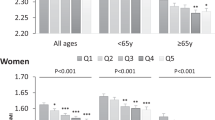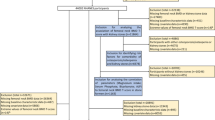Abstract
Summary
Because kidney dysfunction reduces the ability to excrete dietary acid excess, we hypothesized that underlying kidney function may have confounded the mixed studies linking dietary acid load with the risk of osteoporosis and fractures in the community. In a relatively large survey of elderly men and women, we report that dietary acid load did neither associate with DEXA-estimated bone mineral density nor with fracture risk. Underlying kidney function did not modify these null findings. Our results do not support the dietary acid-base hypothesis of bone loss.
Introduction
Impaired renal function reduces the ability to excrete dietary acid excess. We here investigate the association between dietary acid load and bone mineral density (BMD), osteoporosis, and fracture risk by renal function status.
Methods
An observational study was conducted in 861 community-dwelling 70-year-old men and women (49 % men) with complete dietary data from the Prospective Investigation of the Vasculature in Uppsala Seniors (PIVUS). The exposure was dietary acid load as estimated from 7-day food records by the net endogenous acid production (NEAP) and potential renal acid load (PRAL) algorithms. Renal function assessed by cystatin C estimated glomerular filtration rate was reduced in 21 % of the individuals. Study outcomes were BMD and osteoporosis state (assessed by DEXA) and time to fracture (median follow-up of 9.2 years).
Results
In cross-section, dietary acid load had no significant associations with BMD or with the diagnosis of osteoporosis. During follow-up, 131 fractures were validated. Neither NEAP (adjusted hazard ratios (HR) (95 % confidence interval (CI)), 1.01 (0.85–1.21), per 1 SD increment) nor PRAL (adjusted HR (95 % CI), 1.07 (0.88–1.30), per 1 SD increment) associated with fracture risk. Further multivariate adjustment for kidney function or stratification by the presence of kidney disease did not modify these null associations.
Conclusions
The hypothesis that dietary acid load associates with reduced BMD or increased fracture risk was not supported by this study in community-dwelling elderly individuals. Renal function did not influence on this null finding.


Similar content being viewed by others
References
Chrischilles EA, Butler CD, Davis CS, Wallace RB (1991) A model of lifetime osteoporosis impact. Arch Intern Med 151:2026–2032
Burge R, Dawson-Hughes B, Solomon DH, Wong JB, King A, Tosteson A (2007) Incidence and economic burden of osteoporosis-related fractures in the United States, 2005–2025. J Bone Miner Res 22:465–475
Tucker KL, Hannan MT, Kiel DP (2001) The acid-base hypothesis: diet and bone in the Framingham Osteoporosis Study. Eur J Nutr 40:231–237
Fenton TR, Lyon AW, Eliasziw M, Tough SC, Hanley DA (2009) Meta-analysis of the effect of the acid-ash hypothesis of osteoporosis on calcium balance. J Bone Miner Res 24:1835–1840
Hanley DA, Whiting SJ (2013) Does a high dietary acid content cause bone loss, and can bone loss be prevented with an alkaline diet? J Clin Densitom 16:420–425
Sebastian A, Frassetto LA, Sellmeyer DE, Merriam RL, Morris RC Jr (2002) Estimation of the net acid load of the diet of ancestral preagricultural Homo sapiens and their hominid ancestors. Am J Clin Nutr 76:1308–1316
Remer T, Manz F (1995) Potential renal acid load of foods and its influence on urine pH. J Am Diet Assoc 95:791–797
Kurtz I, Maher T, Hulter HN, Schambelan M, Sebastian A (1983) Effect of diet on plasma acid-base composition in normal humans. Kidney Int 24:670–680
Amodu A, Abramowitz MK (2013) Dietary acid, age, and serum bicarbonate levels among adults in the United States. Clin J Am Soc Nephrol 8:2034–2042
Sebastian A, Harris ST, Ottaway JH, Todd KM, Morris RC (1994) Improved mineral balance and skeletal metabolism in postmenopausal women treated with potassium bicarbonate. N Engl J Med 330:1776–1781
Sellmeyer DE, Stone KL, Sebastian A, Cummings SR, G SOFR (2001) A high ratio of dietary animal to vegetable protein increases the rate of bone loss and the risk of fracture in postmenopausal women. Am J Clin Nutr 73:118–122
Krieger NS, Frick KK, Bushinsky DA (2004) Mechanism of acid-induced bone resorption. Curr Opin Nephrol Hypertens 13:423–436
Fenton TR, Eliasziw M, Tough SC, Lyon AW, Brown JP, Hanley DA (2010) Low urine pH and acid excretion do not predict bone fractures or the loss of bone mineral density: a prospective cohort study. BMC Musculoskelet Dis 11:88
Litzow JR, Lemann J Jr, Lennon EJ (1967) The effect of treatment of acidosis on calcium balance in patients with chronic azotemic renal disease. J Clin Invest 46:280–286
Welch AA, Bingham SA, Reeve J, Khaw KT (2007) More acidic dietary acid-base load is associated with reduced calcaneal broadband ultrasound attenuation in women but not in men: results from the EPIC-Norfolk cohort study. Am J Clin Nutr 85:1134–1141
New SA, MacDonald HM, Campbell MK, Martin JC, Garton MJ, Robins SP, Reid DM (2004) Lower estimates of net endogenous non-carbonic acid production are positively associated with indexes of bone health in premenopausal and perimenopausal women. Am J Clin Nutr 79:131–138
Wynn E, Lanham-New SA, Krieg MA, Whittamore DR, Burckhardt P (2008) Low estimates of dietary acid load are positively associated with bone ultrasound in women older than 75 years of age with a lifetime fracture. J Nutr 138:1349–1354
Rahbar A, Larijani B, Nabipour I, Mohamadi MM, Mirzaee K, Amiri Z (2009) Relationship among dietary estimates of net endogenous acid production, bone mineral density and biochemical markers of bone turnover in an Iranian general population. Bone 45:876–881
Macdonald HM, New SA, Fraser WD, Campbell MK, Reid DM (2005) Low dietary potassium intakes and high dietary estimates of net endogenous acid production are associated with low bone mineral density in premenopausal women and increased markers of bone resorption in postmenopausal women. Am J Clin Nutr 81:923–933
Feskanich D, Willett WC, Stampfer MJ, Colditz GA (1996) Protein consumption and bone fractures in women. Am J Epidemiol 143:472–479
Dargent-Molina P, Sabia S, Touvier M, Kesse E, Breart G, Clavel-Chapelon F, Boutron-Ruault MC (2008) Proteins, dietary acid load, and calcium and risk of postmenopausal fractures in the E3N French women prospective study. J Bone Miner Res 23:1915–1922
Bonjour JP (2013) Nutritional disturbance in acid–base balance and osteoporosis: a hypothesis that disregards the essential homeostatic role of the kidney. Br J Nutr 110:1168–1177
Munger RG, Cerhan JR, Chiu BC (1999) Prospective study of dietary protein intake and risk of hip fracture in postmenopausal women. Am J Clin Nutr 69:147–152
Hallan SI, Dahl K, Oien CM, Grootendorst DC, Aasberg A, Holmen J, Dekker FW (2006) Screening strategies for chronic kidney disease in the general population: follow-up of cross sectional health survey. BMJ 333:1047
Lind L, Andersson J, Ronn M, Gustavsson T, Holdfelt P, Hulthe J, Elmgren A, Zilmer K, Zilmer M (2008) Brachial artery intima-media thickness and echogenicity in relation to lipids and markers of oxidative stress in elderly subjects:–the Prospective Investigation of the Vasculature in Uppsala Seniors (PIVUS) study. Lipids 43:133–141
Becker W (1999) Dietary guidelines and patterns of food and nutrient intake in Sweden. Br J Nutr 81(Suppl 2):S113–S117
Willett W, Stampfer MJ (1986) Total energy intake: implications for epidemiologic analyses. Am J Epidemiol 124:17–27
Remer T, Dimitriou T, Manz F (2003) Dietary potential renal acid load and renal net acid excretion in healthy, free-living children and adolescents. Am J Clin Nutr 77:1255–1260
Frassetto LA, Todd KM, Morris RC Jr, Sebastian A (1998) Estimation of net endogenous noncarbonic acid production in humans from diet potassium and protein contents. Am J Clin Nutr 68:576–583
Kanis JA, Adachi JD, Cooper C et al (2013) Standardising the descriptive epidemiology of osteoporosis: recommendations from the Epidemiology and Quality of Life Working Group of IOF. Osteoporos Int 24:2763–2764
Larsson A, Malm J, Grubb A, Hansson LO (2004) Calculation of glomerular filtration rate expressed in mL/min from plasma cystatin C values in mg/L. Scand J Clin Lab Invest 64:25–30
Grubb A, Horio M, Hansson LO et al (2014) Generation of a new cystatin C-based estimating equation for glomerular filtration rate by use of 7 assays standardized to the international calibrator. Clin Chem 60:974–986
McLean RR, McLennan CE, Qiao N, Broe KE, Tucker KL, Cupples LA, Hannan MT (2007) Net endogenous acid production (NEAP) and bone mineral density in men and women: the Framingham Offspring Study. J Bone Miner Res 22:S307
Fulgoni VL 3rd (2008) Current protein intake in America: analysis of the National Health and Nutrition Examination Survey, 2003–2004. Am J Clin Nutr 87:1554S–1557S
May RC, Kelly RA, Mitch WE (1986) Metabolic acidosis stimulates protein degradation in rat muscle by a glucocorticoid-dependent mechanism. J Clin Invest 77:614–621
McLean RR, Qiao N, Broe KE, Tucker KL, Casey V, Cupples LA, Kiel DP, Hannan MT (2011) Dietary acid load is not associated with lower bone mineral density except in older men. J Nutr 141:588–594
New SA (2003) Intake of fruit and vegetables: implications for bone health. Proc Nutr Soc 62:889–899
Welch AA, MacGregor AJ, Skinner J, Spector TD, Moayyeri A, Cassidy A (2013) A higher alkaline dietary load is associated with greater indexes of skeletal muscle mass in women. Osteoporos Int 24:1899–1908
Thorpe DL, Knutsen SF, Beeson WL, Rajaram S, Fraser GE (2008) Effects of meat consumption and vegetarian diet on risk of wrist fracture over 25 years in a cohort of peri- and postmenopausal women. Public Health Nutr 11:564–572
Muhlbauer RC, Lozano A, Reinli A (2002) Onion and a mixture of vegetables, salads, and herbs affect bone resorption in the rat by a mechanism independent of their base excess. J Bone Miner Res 17:1230–1236
Frassetto LA, Morris RC Jr, Sebastian A (1996) Effect of age on blood acid-base composition in adult humans: role of age-related renal functional decline. Am J Physiol 271:F1114–F1122
Hsu CY, Cummings SR, McCulloch CE, Chertow GM (2002) Bone mineral density is not diminished by mild to moderate chronic renal insufficiency. Kidney Int 61:1814–1820
Eustace JA, Astor B, Muntner PM, Ikizler TA, Coresh J (2004) Prevalence of acidosis and inflammation and their association with low serum albumin in chronic kidney disease. Kidney Int 65:1031–1040
Schatzkin A, Kipnis V, Carroll RJ, Midthune D, Subar AF, Bingham S, Schoeller DA, Troiano RP, Freedman LS (2003) A comparison of a food frequency questionnaire with a 24-hour recall for use in an epidemiological cohort study: results from the biomarker-based Observing Protein and Energy Nutrition (OPEN) study. Int J Epidemiol 32:1054–1062
Acknowledgments
This work was supported by the grants from the Swedish Research Council. Baxter Novum is the result of a grant from Baxter Healthcare Corporation to Karolinska Institutet.
Conflicts of interest
BL is affiliated with Baxter Healthcare Corporation. TEL is an employee of Astellas. Ting Jia, Liisa Byberg, Lars Lind, Karl Michaëlsson, and Juan Jesus Carrero declare that they have no conflict of interest.
Author information
Authors and Affiliations
Corresponding author
Electronic supplementary material
Below is the link to the electronic supplementary material.
Supplemental figure
(DOCX 56 kb)
Supplemental table
(DOCX 18 kb)
Rights and permissions
About this article
Cite this article
Jia, T., Byberg, L., Lindholm, B. et al. Dietary acid load, kidney function, osteoporosis, and risk of fractures in elderly men and women. Osteoporos Int 26, 563–570 (2015). https://doi.org/10.1007/s00198-014-2888-x
Received:
Accepted:
Published:
Issue Date:
DOI: https://doi.org/10.1007/s00198-014-2888-x




